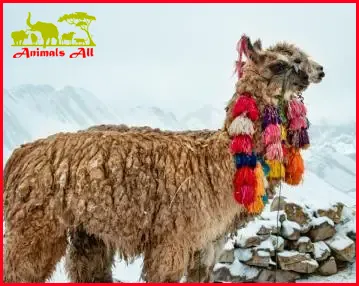
Alpaca and Llama: The Ultimate Showdown
alpaca and llama, may seem similar at first glance, but there’s more to them than meets the eye. These South American animals have their own unique traits that make them stand out. In this article, we’ll take a closer look at alpacas and llamas, exploring how they differ in size, appearance, personality, and uses.

Why Compare Alpacas and Llamas?
You might be wondering why we’re comparing alpacas and llamas in the first place. After all, they’re both part of the same family. Well, the truth is that even though they share some similarities, they also have distinct qualities that deserve recognition.
By learning about what makes alpacas and llamas alike and different, we can develop a deeper understanding and appreciation for these incredible creatures.
Throughout this article, we’ll cover various aspects of alpacas and llamas, including their physical differences, fiber production, historical importance, cultural significance, and more. Our goal is to provide you with a comprehensive view of these animals so that you can truly grasp their beauty and significance.
So let’s dive in!
1. Alpacas and Llamas: Similarities and Differences
Alpacas and llamas, both South American camelids, share some similarities but also have distinct differences that set them apart. Let’s explore the various aspects that make these two fascinating animals unique.
Background information on alpacas and llamas as South American camelids
- Alpacas and llamas belong to the same family of animals called Camelidae, which also includes camels.
- They are native to the Andes Mountains of Peru, Ecuador, and Bolivia, where they have been domesticated for thousands of years.
- These animals have played a significant role in the lives of indigenous people in the region, providing them with food, fiber, transportation, and even cultural importance.
Size, weight, and appearance differences (with images)
- Alpacas are smaller than llamas, standing at around 90 cm high and weighing between 55-65 kg.
- Llamas, on the other hand, are larger with an average height of 120 cm and can weigh up to 113 kg.
- In terms of appearance, alpacas have a more compact body shape compared to the taller and leaner build of llamas.
Fiber production: Alpaca fleece and llama wool

- One of the most notable distinctions between alpacas and llamas lies in their fiber production.
- Alpacas produce luxurious fleece that is highly prized for its softness, warmth, and hypoallergenic qualities. The fineness of alpaca fiber makes it ideal for crafting garments such as sweaters, scarves, and hats. You can learn more about alpaca fleece here.
- Llamas, on the other hand, produce coarser wool that is often used for making rugs, blankets, and other heavy-duty textile products.
Personality traits: Shyness and confidence, herd behavior and independence
- Alpacas are known for their shy and timid nature. They tend to be more reserved and cautious around humans, often requiring patience and gentle handling.
- Llamas, on the other hand, exude confidence and are generally more outgoing. They can be quite curious and sociable, readily approaching people or investigating new surroundings.
- Additionally, alpacas are highly social animals that prefer living in herds, while llamas exhibit a greater sense of independence.
Uses and purposes: Alpacas for fiber, llamas as pack animals and guards
- Alpacas are primarily bred for their luxurious fleece, which is sought after by artisans and fiber enthusiasts worldwide. Their gentle temperament makes them well-suited for fiber production.
- Llamas, on the other hand, have a long history of serving as pack animals due to their strength and endurance. They can carry heavy loads over rugged terrains, making them valuable companions on treks or expeditions.
- Moreover, llamas also excel as guard animals for livestock such as sheep or goats. Their alertness and natural instinct to protect make them effective guardians against potential predators.
By understanding the similarities and
2. Physiological Distinctions Between Alpacas and Llamas
Llamas and alpacas are both fascinating creatures with distinct physical characteristics that set them apart. Understanding these physiological differences can help us appreciate the unique traits of each animal.
Facial Features
The alpaca’s adorable blunt-nosed face is adorned with a generous amount of fur, giving it a charming and fluffy appearance. On the other hand, the llama boasts a longer nose with less facial fur, exuding a different kind of elegance.
Ears
One noticeable difference between alpacas and llamas lies in their ears. Alpacas have straight, pointed ears, adding to their endearing countenance. Meanwhile, llamas sport long, banana-shaped ears that contribute to their distinctive appearance.
Snouts
Another differentiating factor is the length of their snouts. Alpacas have shorter snouts, while llamas exhibit longer snouts. This variance in snout length plays a role in their feeding habits and further sets them apart from each other.
These distinctions in their facial features, ears, and snouts are just a few examples of the captivating dissimilarities between alpacas and llamas. Appreciating these unique attributes adds depth to our understanding of these remarkable South American camelids.

3. Fiber Comparison: Alpaca and Llama
When it comes to fiber, both alpacas and llamas offer unique qualities, but there are distinct differences between the two.
Fiber Characteristics:
Alpaca’s fine wool:
Alpacas produce a luxurious and soft fiber that is highly sought after for its quality and versatility. The fleece of an alpaca is known for its fineness, which makes it suitable for garments such as sweaters, scarves, and hats. The fibers are incredibly soft against the skin and have a natural luster that adds a touch of luxury to any product.
Llama’s coarser wool:
On the other hand, llamas produce a coarser fiber compared to alpacas. Llama wool is known for its durability and strength, making it ideal for rugs, blankets, and other sturdy textiles. While not as soft as alpaca fiber, llama wool still offers warmth and insulation.
Microns Measurement:
Alpaca fiber:
The fineness of alpaca fiber is measured in microns, with a range of 18-30 microns. The lower the micron count, the finer and softer the fiber. This fine texture allows for comfortable wear against the skin without any itchiness or irritation.
Llama fiber:
In contrast, llama fiber has a higher micron count ranging from 50-65 microns. Although coarser than alpaca fiber, it still provides excellent warmth and durability.
Uses of Alpaca and Llama Fiber:
Both alpaca and llama fibers have found their place in various industries due to their unique characteristics:
- Alpaca fiber: With its softness and versatility, alpaca fiber is highly valued in the fashion industry. It is used to create high-quality garments such as sweaters, shawls, socks, and even luxurious bedding products.
- Llama fiber: Llama wool, with its durability and strength, is often utilized in the production of rugs, blankets, and other heavy-duty textiles. Its sturdiness makes it well-suited for outdoor applications.
The distinct qualities of alpaca and llama fiber make them suitable for different purposes. Whether you’re looking for softness and luxury or durability and strength, both alpaca and llama fibers have something unique to offer.
4. Historical and Cultural Significance
Llamas and alpacas have a rich historical and cultural significance, particularly in the Andes Mountains of Peru, Ecuador, and Bolivia. Some key points to consider are:
- Origins in the Andes Mountains: Llamas and alpacas have been integral to the cultural fabric of these regions for centuries. Their ability to thrive at high altitudes made them essential for the survival of indigenous communities.
- Contributions to trade and religious purposes in the Inca civilization: The Inca civilization greatly valued llamas and alpacas for their wool and strength. Llamas were used as pack animals, transporting goods across challenging terrains, while alpacas provided fine wool for clothing and textiles. Additionally, these animals held significant religious symbolism within Incan rituals and traditions.
- Impact of the Spanish conquest on llama and alpaca populations: The arrival of the Spanish conquistadors had a devastating impact on llama and alpaca populations. The exploitation and disruption caused by colonization led to a drastic decline in their numbers.
- Population rebound after 300 years: Despite the challenges they faced during the Spanish conquest, llamas and alpacas resiliently rebounded over time. Through concerted conservation efforts and a renewed appreciation for their unique qualities, their populations gradually recovered, securing their enduring presence in South American culture.
The enduring historical significance of llamas and alpacas is a testament to their cultural importance and resilience in the face of adversity.
Conclusion
After exploring the unique characteristics and uses of alpacas and llamas, it’s clear that both these South American camelids deserve our admiration. Their distinct qualities contribute to the diversity of the animal kingdom and have made them invaluable to various cultures and industries. From the fine wool of alpacas to the strength and utility of llamas, each animal brings something special to the table.
- Alpaca and llama characteristics showcase a fascinating contrast in temperament, appearance, and fiber quality.
- The uses of llamas as pack animals and guards, contrasted with alpacas’ role in the fiber industry, highlight their versatility.
- While alpaca and llama breeding can lead to hybrid animals known as “huacaya” or “suri,” each species maintains its individual traits and purposes.
In essence, both alpacas and llamas offer unique contributions that make them integral parts of their native environments and beyond. Let’s continue to celebrate these remarkable creatures for their distinctive attributes that enrich our world.


One thought on “Alpaca and Llama: The Ultimate Showdown”
Comments are closed.